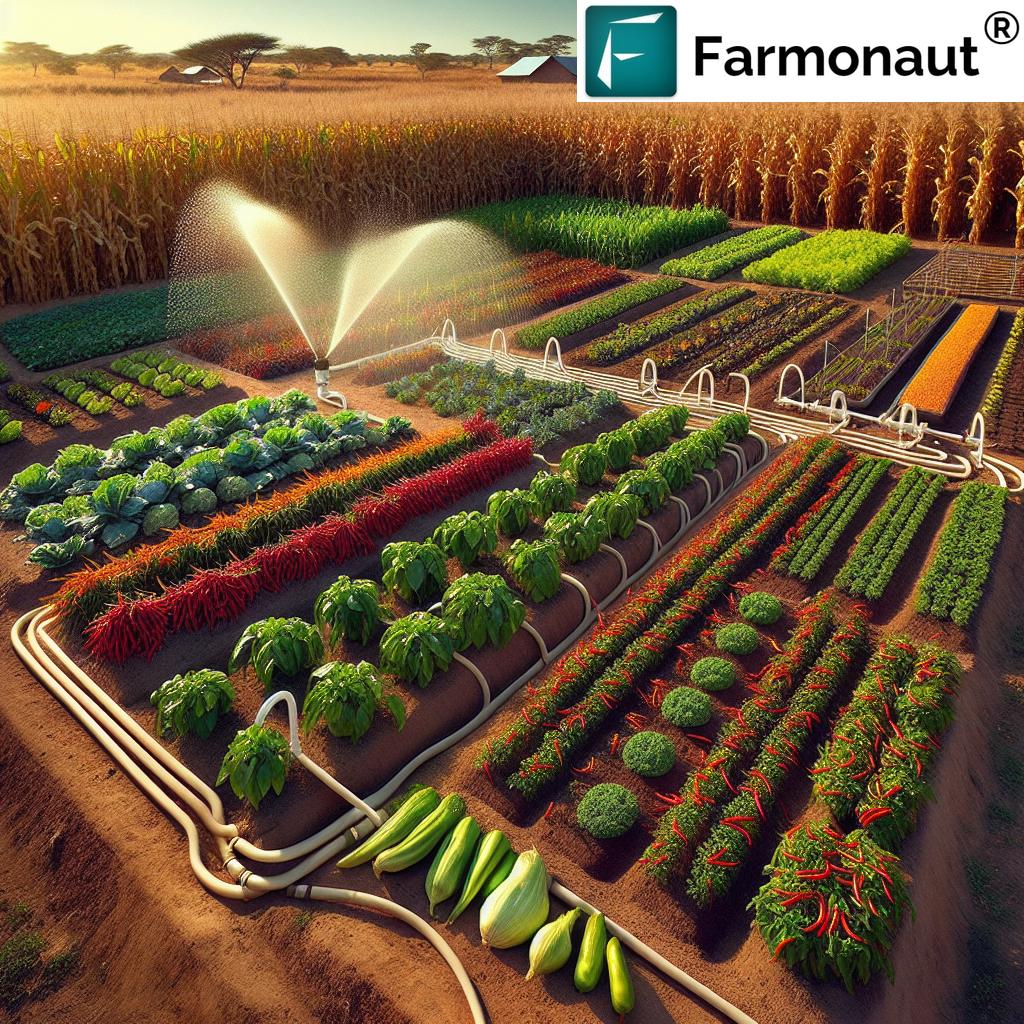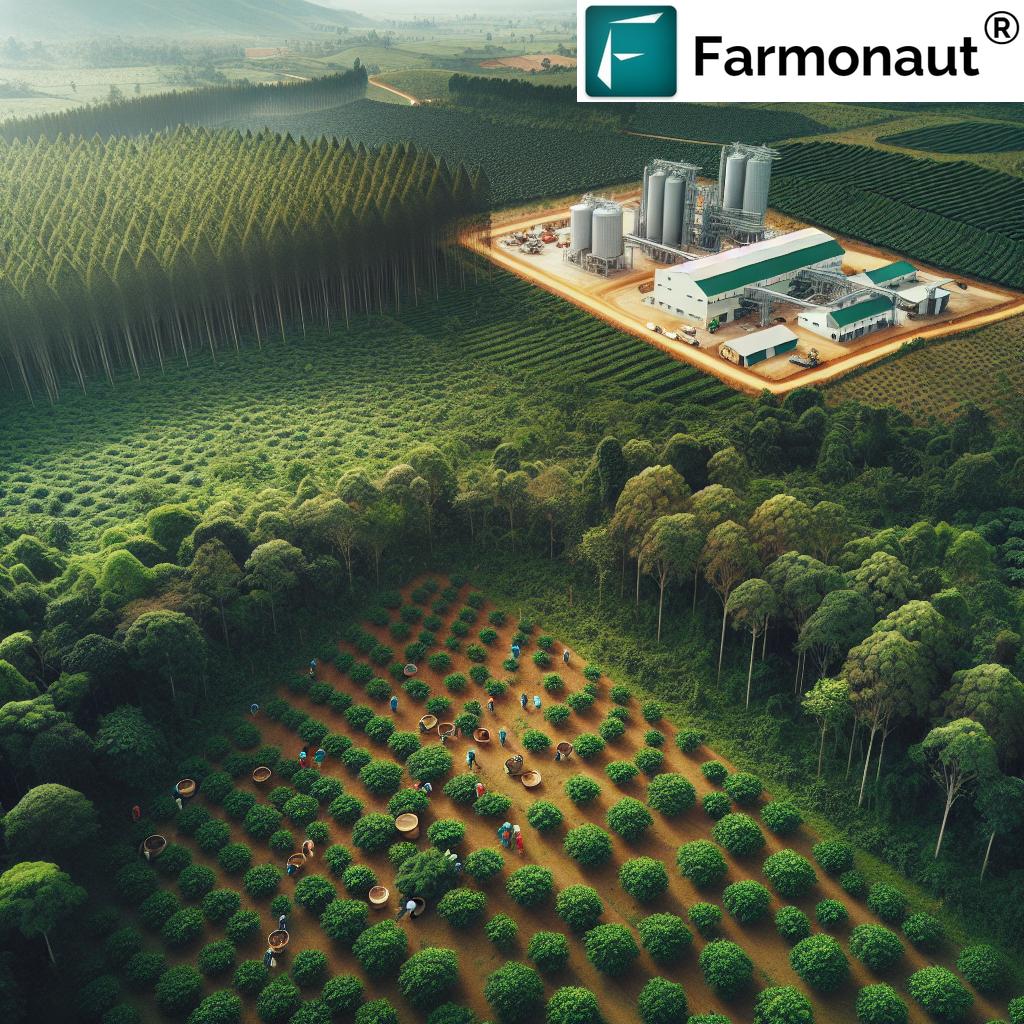Climate-Smart Agriculture in Zimbabwe: How Farmers Are Adapting to Drought with Innovative Crops and Techniques
“Zimbabwe’s shift to drought-resistant crops like chilies and millets has increased agricultural resilience by up to 40% in arid regions.”
In the face of increasingly unpredictable weather patterns and prolonged droughts, farmers in Zimbabwe are at the forefront of a revolutionary change in agricultural practices. We’re witnessing a remarkable transformation as traditional farming methods give way to climate-smart agriculture, a shift that’s not just sustaining livelihoods but also ensuring food security in this southeastern African nation. In this comprehensive exploration, we’ll delve into how Zimbabwean farmers are adapting to drought conditions with innovative crops and techniques, and examine the far-reaching implications of these changes for global agriculture.
The Changing Face of Zimbabwean Agriculture
Zimbabwe, once known as the breadbasket of Africa, has faced significant challenges in recent years due to climate change. The country’s agricultural sector, which has long been the backbone of its economy, is now grappling with the harsh realities of prolonged droughts and erratic rainfall patterns. These environmental changes have forced farmers to rethink their traditional approaches and embrace new, more resilient farming methods.
In the arid district of Chipinge, we see a perfect example of this agricultural evolution. Farmers like 49-year-old Gertrude Siduna have made the bold decision to abandon corn cultivation, a staple crop deeply ingrained in Zimbabwean culture and diet, in favor of more drought-resistant alternatives. This shift is not just a matter of crop preference; it’s a survival strategy in the face of climate uncertainty.

The Rise of Drought-Resistant Crops
One of the most significant changes in Zimbabwe’s agricultural landscape is the adoption of drought-resistant crops. Chilies and millets are emerging as popular alternatives to traditional corn farming. These crops not only thrive in hotter and drier conditions but also offer farmers a more reliable source of income.
- Chilies: Farmers like Siduna have found success with chili cultivation. Earning approximately $400 from her chili harvests, Siduna reports that these spicy peppers offer a dependable return compared to water-dependent corn. The ability of chilies to withstand harsh conditions makes them an ideal crop for regions experiencing frequent droughts.
- Millets: Another crop gaining popularity is millet. Known for its resilience in poor soils and dry conditions, millet is becoming a go-to option for many farmers. Kenias Chikamhi, a farmer in Chiredzi, describes growing corn as a “gamble,” while praising millets for their consistency during adverse weather conditions.
These drought-resistant crops are not just alternatives; they’re lifelines for farmers in arid regions. By diversifying their crop portfolio, farmers are spreading their risk and ensuring a more stable income, even in the face of unpredictable weather patterns.
Innovative Irrigation Solutions
“Solar-powered irrigation systems have boosted crop yields by 30% in Zimbabwean community gardens, enhancing food security for thousands.”
Water scarcity is a critical issue in many parts of Zimbabwe, making efficient irrigation a top priority for farmers. In response to this challenge, innovative solutions are being implemented across the country. One such solution is the introduction of solar-powered irrigation systems, particularly in community gardens.
These solar-powered systems, supported by organizations like the U.S. Agency for International Development (USAID), are revolutionizing small-scale farming. By providing a reliable water supply, these systems enable farmers to cultivate a diverse range of vegetables without the burden of transporting water from distant sources. This not only saves time and energy but also significantly increases crop yields.
The benefits of these irrigation systems extend beyond individual farms. Community initiatives fostered by these projects encourage cooperation among local farmers, allowing them to share resources and reduce their reliance on external aid. This collaborative approach is strengthening the resilience of entire communities against the impacts of climate change.
Sustainable Farming Practices
Climate-smart agriculture in Zimbabwe goes beyond crop selection and irrigation. It encompasses a range of sustainable farming practices that help conserve resources and improve soil health. Some of these practices include:
- Mulching: This technique helps retain soil moisture, reduce erosion, and suppress weed growth.
- Crop rotation: By alternating crops, farmers can improve soil fertility and break pest cycles naturally.
- Intercropping: Growing multiple crops in the same field can maximize land use and provide natural pest control.
- Conservation tillage: Minimizing soil disturbance helps preserve soil structure and organic matter.
These practices not only help farmers adapt to changing climate conditions but also contribute to long-term soil health and sustainability. By implementing these techniques, Zimbabwean farmers are not just surviving; they’re laying the groundwork for a more resilient agricultural future.
The Role of Technology in Climate-Smart Agriculture
As Zimbabwe embraces climate-smart agriculture, technology is playing an increasingly important role. Advanced tools and platforms are helping farmers make more informed decisions and manage their resources more efficiently. One such technological solution is offered by Farmonaut, a pioneering agricultural technology company.
Farmonaut provides satellite-based farm management solutions that are particularly valuable in the context of climate-smart agriculture. Through its android, iOS, and web applications, as well as its API, Farmonaut offers services such as:
- Real-time crop health monitoring
- AI-based advisory systems
- Resource management tools
These tools can help Zimbabwean farmers monitor their crops more effectively, predict potential issues, and optimize resource use. For instance, satellite imagery can provide insights into vegetation health and soil moisture levels, enabling farmers to make timely decisions about irrigation and crop management.
To explore how Farmonaut’s technology can benefit your farming operations, consider checking out their services:
Government Initiatives and Support
While farmers are at the forefront of this agricultural transformation, the Zimbabwean government is also playing a crucial role in promoting climate-smart agriculture. The agriculture ministry continues to support maize farming by promoting techniques designed to improve drought resilience, such as:
- Encouraging the use of drought-tolerant seed varieties
- Promoting water conservation techniques
- Providing training and resources for sustainable farming practices
These government initiatives, combined with the efforts of international organizations and NGOs, are creating a supportive environment for farmers to transition to more resilient agricultural practices.

Global Implications and International Assistance
The agricultural transformation happening in Zimbabwe has significant implications for global food security and climate change adaptation. As climate change continues to affect agricultural regions worldwide, the lessons learned and techniques developed in Zimbabwe could provide valuable insights for other countries facing similar challenges.
International development assistance plays a crucial role in supporting these agricultural adaptations. Organizations like USAID are not only providing financial support but also bringing in expertise and technology to help Zimbabwean farmers transition to more resilient farming methods. However, experts argue that humanitarian strategies must evolve to address the root causes of hunger, particularly those exacerbated by climate change and geopolitical instability.
Daniel Maxwell, a food security expert, emphasizes the necessity for a comprehensive approach that integrates health, safety, and nutritional considerations within aid initiatives. This holistic approach is essential for creating sustainable solutions that go beyond short-term relief.
Challenges and Future Outlook
While the shift towards climate-smart agriculture in Zimbabwe is promising, it’s not without its challenges. Some of the key obstacles include:
- Limited access to resources and technology for small-scale farmers
- The need for extensive training and education on new farming techniques
- The initial costs associated with transitioning to new crops and farming methods
- Cultural attachment to traditional crops like corn
Despite these challenges, the future outlook for Zimbabwean agriculture is cautiously optimistic. As more farmers experience the benefits of climate-smart agriculture, adoption rates are likely to increase. Moreover, ongoing research and development in drought-resistant crops and sustainable farming techniques continue to provide new options for farmers.
Comparative Analysis: Traditional vs. Climate-Smart Agriculture in Zimbabwe
| Agricultural Aspect | Traditional Approach | Climate-Smart Approach | Benefits of Climate-Smart Approach | Challenges in Implementation |
|---|---|---|---|---|
| Crop Selection | Primarily corn (maize) | Drought-resistant crops (e.g., chilies, millets) | Higher resilience to drought, improved income stability | Cultural adaptation, market development for new crops |
| Irrigation Methods | Rain-fed or manual irrigation | Solar-powered irrigation systems | Consistent water supply, increased crop yields | Initial investment costs, technical know-how |
| Soil Management | Conventional tillage | Conservation tillage, mulching | Improved soil health, water retention | Requires training, initial yield adjustments |
| Pest Management | Heavy reliance on chemical pesticides | Integrated Pest Management (IPM) | Reduced environmental impact, cost-effective | Knowledge-intensive, requires ongoing monitoring |
| Yield Expectations | Highly variable, dependent on rainfall | More stable, though potentially lower in dry years | Consistent food supply and income | Adapting to new yield patterns and market demands |
The Role of Technology in Enhancing Climate-Smart Agriculture
As we’ve seen, technology plays a crucial role in supporting climate-smart agriculture in Zimbabwe. Platforms like Farmonaut offer valuable tools for farmers transitioning to more resilient farming practices. For those interested in exploring how satellite-based farm management can enhance their agricultural operations, Farmonaut provides various subscription options:
For developers and businesses looking to integrate Farmonaut’s satellite and weather data into their own systems, the company also offers API access. You can find more information about the API and its documentation here:
Conclusion: A Resilient Future for Zimbabwean Agriculture
The transformation of Zimbabwe’s agricultural sector in the face of climate change is a testament to the resilience and adaptability of its farmers. By embracing climate-smart agriculture, including drought-resistant crops, innovative irrigation techniques, and sustainable farming practices, Zimbabwean farmers are not just surviving; they’re paving the way for a more secure and sustainable food future.
While challenges remain, the combination of farmer innovation, government support, international assistance, and technological advancements offers hope for overcoming the hurdles posed by climate change. As Zimbabwe continues to adapt and evolve its agricultural practices, it provides valuable lessons for other countries facing similar climate-related challenges.
The journey towards climate-smart agriculture in Zimbabwe is ongoing, but the progress made so far is encouraging. It demonstrates that with the right approaches, technologies, and support, it’s possible to build a resilient agricultural sector capable of withstanding the impacts of climate change while ensuring food security for generations to come.
FAQs
- What is climate-smart agriculture?
Climate-smart agriculture is an approach that helps guide actions needed to transform and reorient agricultural systems to effectively support development and ensure food security in a changing climate. It aims to tackle three main objectives: sustainably increasing agricultural productivity and incomes, adapting and building resilience to climate change, and reducing and/or removing greenhouse gas emissions, where possible. - Why are Zimbabwean farmers shifting away from corn cultivation?
Farmers in Zimbabwe are moving away from corn due to its high vulnerability to drought. With increasing frequency and severity of droughts due to climate change, corn yields have become unreliable, prompting farmers to seek more drought-resistant alternatives. - What are some of the drought-resistant crops being adopted in Zimbabwe?
Farmers in Zimbabwe are increasingly adopting crops like chilies and millets, which are more resilient to hot and dry conditions. These crops not only withstand drought better but also provide a more stable income for farmers. - How are solar-powered irrigation systems helping Zimbabwean farmers?
Solar-powered irrigation systems are providing a reliable water supply for community gardens, allowing farmers to cultivate diverse vegetables without depending on distant water sources. These systems have significantly increased crop yields and improved food security. - What role does technology play in climate-smart agriculture in Zimbabwe?
Technology, such as satellite-based farm management solutions offered by companies like Farmonaut, plays a crucial role in climate-smart agriculture. These technologies provide real-time crop health monitoring, AI-based advisory systems, and resource management tools, helping farmers make informed decisions and optimize their operations. - How is the Zimbabwean government supporting the transition to climate-smart agriculture?
The Zimbabwean government is supporting the transition by promoting drought-tolerant seed varieties, encouraging water conservation techniques, and providing training and resources for sustainable farming practices. They are also working alongside international organizations to create a supportive environment for farmers adopting new agricultural methods. - What are some challenges in implementing climate-smart agriculture in Zimbabwe?
Some challenges include limited access to resources and technology for small-scale farmers, the need for extensive training on new farming techniques, initial costs associated with transitioning to new methods, and cultural attachment to traditional crops like corn. - How can international development assistance support climate-smart agriculture in Zimbabwe?
International development assistance can support climate-smart agriculture by providing financial resources, bringing in expertise and technology, and helping to develop comprehensive strategies that address not just agricultural practices but also related issues like health, safety, and nutrition. - What are some sustainable farming practices being adopted in Zimbabwe?
Sustainable farming practices being adopted include mulching, crop rotation, intercropping, and conservation tillage. These practices help conserve resources, improve soil health, and increase resilience to climate variability. - How might Zimbabwe’s agricultural transformation impact global food security?
Zimbabwe’s agricultural transformation could provide valuable insights and models for other countries facing similar climate-related challenges. The successful implementation of climate-smart agriculture in Zimbabwe could contribute to global food security by demonstrating effective strategies for agricultural resilience in the face of climate change.



















